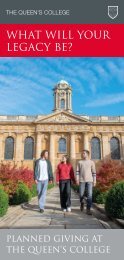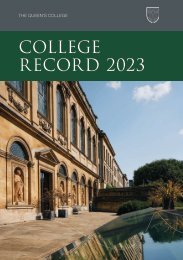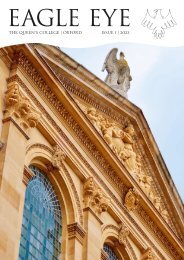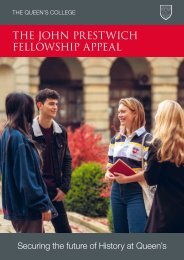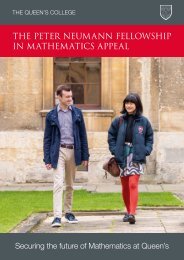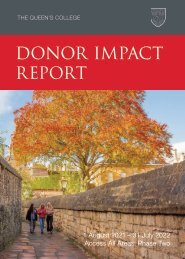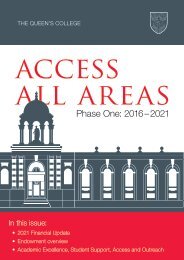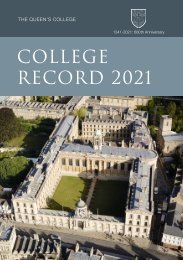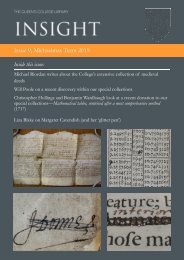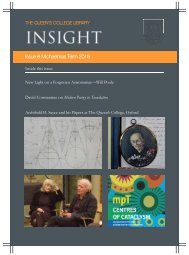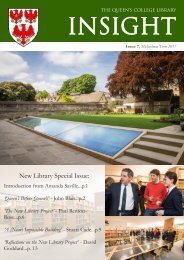The College Record 2022
Create successful ePaper yourself
Turn your PDF publications into a flip-book with our unique Google optimized e-Paper software.
emphasis on his duties within the church than on his Oxford teaching. His successor,<br />
Bartholomew Price (1818–1898), on the other hand, was a committed and highly<br />
regarded teacher of mathematics, who became a prominent personality within the<br />
University, and, towards the end of his life, Master of Pembroke.<br />
<strong>The</strong> tenures of Cooke and Price in the Sedleian Chair straddled a period of reform<br />
within the University. Questions were being asked about the nature of the teaching<br />
at the English universities, and the place of scientific disciplines within this. Such<br />
subjects had little place in college teaching, and were often regarded as irrelevant<br />
by the traditionalists who saw the training of the clergy as the central purpose<br />
of the universities. Such high-level scientific instruction as did exist was provided<br />
centrally by the relevant professors, but their positions had in many cases become<br />
financially precarious, and their lectures often suffered from lack of attendance,<br />
owing to a mismatch between the stipulated teaching and the subjects that were<br />
actually examined.<br />
Articles<br />
Beginning in the 1850s, a series of government commissions investigated the<br />
(scientific) teaching provision at Oxford and Cambridge, and the financial situations<br />
of the colleges, with a view to forcing colleges to subsidize the central professoriate.<br />
Thus, it was that the Sedleian Chair of Natural Philosophy came to be associated<br />
permanently with Queen’s: from 1858, the <strong>College</strong> – apparently willingly – contributed<br />
a portion of the professor’s stipend.<br />
Until this point, the various professorships within the University had not been attached<br />
to particular colleges: they had always been internal appointments, given to people<br />
who already had college associations. To have moved college upon appointment<br />
to a chair would have been unthinkable – or even infeasible, in the cases of figures<br />
such as Hornsby who held more than one such post. But financial contributions to<br />
stipends created natural connections. Bartholomew Price, while remaining a Fellow<br />
of Pembroke, was elected to an Honorary Fellowship of Queen’s in 1868. And when<br />
Augustus Love (1863–1940), Price’s successor as Sedleian Professor, arrived from<br />
Cambridge in 1899 without any other Oxford association, it was natural for him<br />
to become a member of Queen’s. <strong>The</strong> Sedleian Professors have been Fellows of<br />
Queen’s ever since, complete with associated traditions: since the end of the 1950s,<br />
it has been the convention that only the Sedleian Professor or the Patroness of the<br />
<strong>College</strong> may operate the orrery in the Upper Library.<br />
In 1945, as part of post-war concern over the state of physics teaching in the UK, it<br />
was suggested that the Sedleian Chair might be realigned as a post in theoretical<br />
physics rather than applied mathematics, but the change was never made.<br />
One modification that was made to the Sedleian statutes around this time, however,<br />
was the removal of the requirement for the Professor to lecture – thus, what had<br />
begun as a post for teaching Aristotle completed its transformation into the highprofile<br />
research position that it is today.<br />
<strong>College</strong> <strong>Record</strong> <strong>2022</strong> | <strong>The</strong> Queen’s <strong>College</strong> 99






